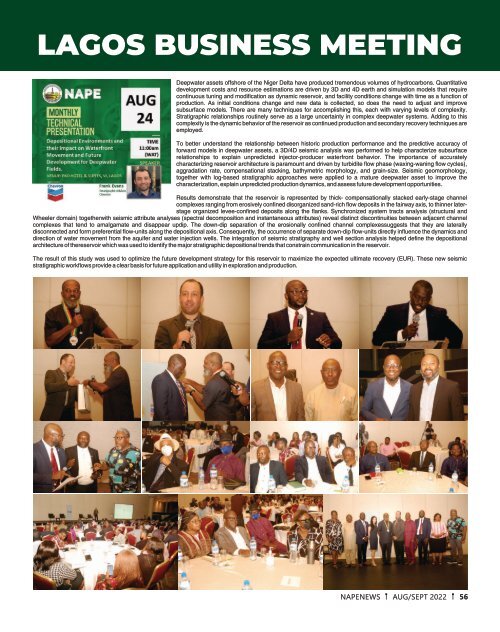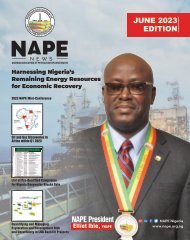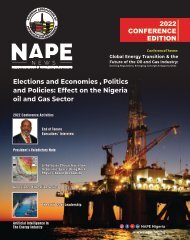You also want an ePaper? Increase the reach of your titles
YUMPU automatically turns print PDFs into web optimized ePapers that Google loves.
LAGOS BUSINESS MEETING<br />
Deepwater assets offshore of the Niger Delta have produced tremendous volumes of hydrocarbons. Quantitative<br />
development costs and resource estimations are driven by 3D and 4D earth and simulation models that require<br />
continuous tuning and modification as dynamic reservoir, and facility conditions change with time as a function of<br />
production. As initial conditions change and new data is collected, so does the need to adjust and improve<br />
subsurface models. There are many techniques for accomplishing this, each with varying levels of complexity.<br />
Stratigraphic relationships routinely serve as a large uncertainty in complex deepwater systems. Adding to this<br />
complexity is the dynamic behavior of the reservoir as continued production and secondary recovery techniques are<br />
employed.<br />
To better understand the relationship between historic production performance and the predictive accuracy of<br />
forward models in deepwater assets, a 3D/4D seismic analysis was performed to help characterize subsurface<br />
relationships to explain unpredicted injector-producer waterfront behavior. The importance of accurately<br />
characterizing reservoir architecture is paramount and driven by turbidite flow phase (waxing-waning flow cycles),<br />
aggradation rate, compensational stacking, bathymetric morphology, and grain-size. Seismic geomorphology,<br />
together with log-based stratigraphic approaches were applied to a mature deepwater asset to improve the<br />
characterization, explain unpredicted production dynamics, and assess future development opportunities.<br />
Results demonstrate that the reservoir is represented by thick- compensationally stacked early-stage channel<br />
complexes ranging from erosively confined disorganized sand-rich flow deposits in the fairway axis, to thinner laterstage<br />
organized levee-confined deposits along the flanks. Synchronized system tracts analysis (structural and<br />
Wheeler domain) togetherwith seismic attribute analyses (spectral decomposition and instantaneous attributes) reveal distinct discontinuities between adjacent channel<br />
complexes that tend to amalgamate and disappear updip. The down-dip separation of the erosionally confined channel complexessuggests that they are laterally<br />
disconnected and form preferential flow-units along the depositional axis. Consequently, the occurrence of separate down-dip flow-units directly influence the dynamics and<br />
direction of water movement from the aquifer and water injection wells. The integration of seismic stratigraphy and well section analysis helped define the depositional<br />
architecture of thereservoir which was used to identify the major stratigraphic depositional trends that constrain communication in the reservoir.<br />
The result of this study was used to optimize the future development strategy for this reservoir to maximize the expected ultimate recovery (EUR). These new seismic<br />
stratigraphic workflows provide a clear basis for future application and utility in exploration and production.<br />
NAPENEWS AUG/SEPT <strong>2022</strong> 56










